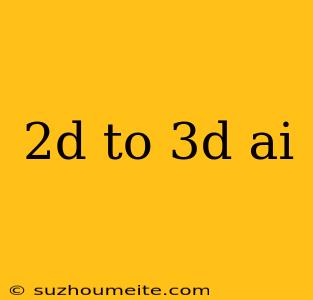2D to 3D AI: Revolutionizing Computer Vision and Graphics
Introduction
The concept of 2D to 3D AI has been gaining significant attention in recent years, with advancements in computer vision, machine learning, and graphics. This technology enables the conversion of 2D images into 3D models, paving the way for a wide range of applications in various fields. In this article, we'll delve into the world of 2D to 3D AI, exploring its principles, applications, and future implications.
How it Works
The process of 2D to 3D AI involves training deep neural networks to learn the patterns and relationships between 2D images and their corresponding 3D models. These networks are typically trained on large datasets of 2D images and their associated 3D models, allowing them to learn the underlying structures and patterns.
The conversion process involves the following steps:
- Image Input: A 2D image is input into the AI system.
- Feature Extraction: The system extracts relevant features from the image, such as edges, contours, and textures.
- Depth Estimation: The system estimates the depth information from the 2D image, creating a depth map.
- 3D Model Generation: The system uses the depth information and feature extraction results to generate a 3D model of the object or scene.
Applications
The applications of 2D to 3D AI are vast and varied, including:
Computer-Aided Design (CAD)
2D to 3D AI can be used to create 3D models from 2D CAD designs, streamlining the design process and reducing prototyping costs.
Virtual Reality (VR) and Augmented Reality (AR)
The technology can be used to create immersive VR and AR experiences, allowing users to interact with 3D models generated from 2D images.
Robotics and Computer Vision
2D to 3D AI can be applied to robotics and computer vision to enable robots to better understand their environment and interact with objects in 3D space.
Film and Video Production
The technology can be used to create realistic 3D models from 2D images, reducing the need for expensive 3D modeling and animation.
Challenges and Limitations
While 2D to 3D AI has made significant progress, there are still several challenges and limitations to be addressed, including:
Data Quality and Availability
The quality and availability of 2D image datasets and corresponding 3D models can impact the accuracy of the conversion process.
Complexity of Scenes
The conversion process can be challenging for complex scenes with multiple objects, varying lighting conditions, and complex textures.
** Occlusion and Ambiguity**
The system may struggle to handle occluded objects or objects with ambiguous depths.
Future Implications
The future of 2D to 3D AI holds much promise, with potential applications in:
Autonomous Systems
Enabling autonomous systems, such as self-driving cars, to better understand and interact with their environment.
Healthcare
Creating personalized 3D models of organs and tissues from 2D medical images, improving diagnosis and treatment planning.
Education
Enhancing educational experiences with interactive 3D models, improving student engagement and understanding.
Conclusion
2D to 3D AI has the potential to revolutionize various industries and fields, enabling the creation of immersive and interactive 3D models from 2D images. While there are challenges to be addressed, the future implications of this technology are vast and exciting. As the technology continues to evolve, we can expect to see widespread adoption and innovative applications across various domains.
